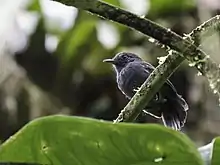Bicolored antvireo
The bicolored antvireo (Dysithamnus occidentalis) is an insectivorous bird in the antbird family Thamnophilidae. It is found on the west slope of the Andes from southwest Colombia to northwest Ecuador. Its natural habitat is subtropical or tropical moist montane forests. It is threatened by habitat loss.
| Bicolored antvireo | |
|---|---|
 | |
| Scientific classification | |
| Kingdom: | Animalia |
| Phylum: | Chordata |
| Class: | Aves |
| Order: | Passeriformes |
| Family: | Thamnophilidae |
| Genus: | Dysithamnus |
| Species: | D. occidentalis |
| Binomial name | |
| Dysithamnus occidentalis (Chapman, 1923) | |
The bicolored antvireo was described by the American ornithologist Frank Chapman in 1923 who considered it a subspecies of the white-shouldered antshrike (Thamnophilus aethiops) and coined the trinomial name Thamnophilus aethiops occidentalis.[2]
There are two subspecies:[3]
- D. o. occidentalis (Chapman, 1923) – southwest Colombia and north Ecuador
- D. o. punctitectus Chapman, 1924 – east Ecuador[4]
References
- BirdLife International (2013). "Dysithamnus occidentalis". IUCN Red List of Threatened Species. 2013. Retrieved 26 November 2013.CS1 maint: ref=harv (link)
- Chapman, Frank (1923). "Descriptions of proposed new Formicariidae and Dendrocolaptidae". American Museum Novitates. 86: 1–20 [2].
- Gill, Frank; Donsker, David, eds. (2018). "Antbirds". World Bird List Version 8.1. International Ornithologists' Union. Retrieved 21 March 2018.
- Chapman, Frank (1924). "Descriptions of new genera and species of Tracheophonae from Panama, Ecuador, Peru and Bolivia". American Museum Novitates. 123: 1-9 [2-3].
This article is issued from Wikipedia. The text is licensed under Creative Commons - Attribution - Sharealike. Additional terms may apply for the media files.
